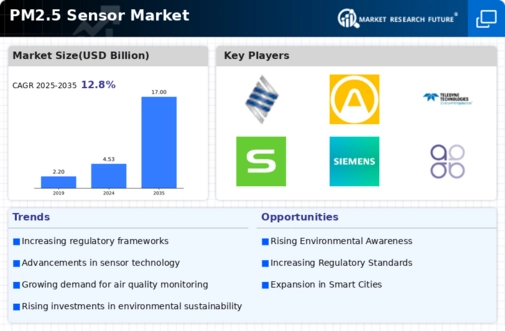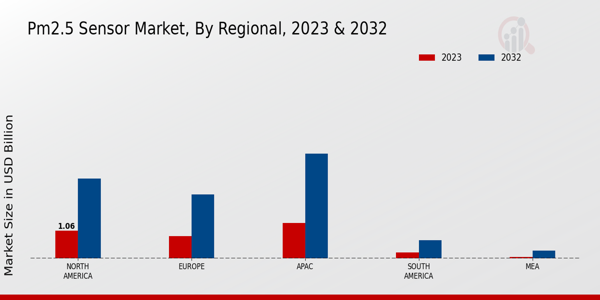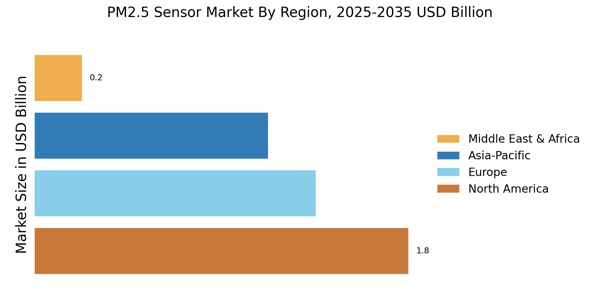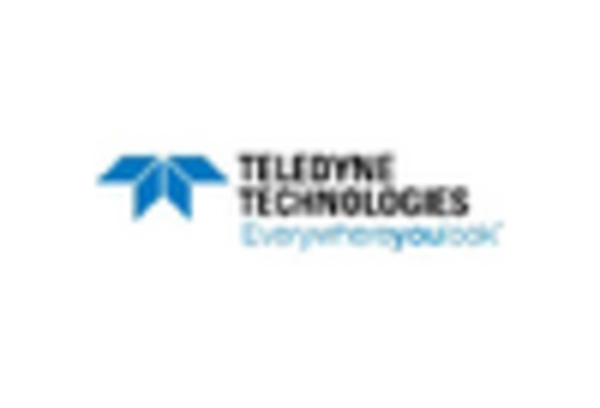Rising Air Quality Concerns
The increasing awareness regarding air quality and its impact on health appears to be a primary driver for the PM2.5 Sensor Market. As urbanization accelerates, the prevalence of air pollution has become a pressing issue, prompting both individuals and governments to seek effective monitoring solutions. Reports indicate that air pollution contributes to millions of premature deaths annually, which has led to heightened public concern. Consequently, the demand for PM2.5 sensors is likely to rise as consumers and organizations strive to ensure cleaner air. This trend is further supported by initiatives aimed at improving air quality standards, which may drive investments in monitoring technologies. The PM2.5 Sensor Market is thus positioned to benefit from this growing emphasis on health and environmental safety.
Government Regulations and Policies
Government regulations aimed at controlling air pollution are likely to significantly influence the PM2.5 Sensor Market. Many countries have established stringent air quality standards, necessitating the implementation of monitoring systems to comply with these regulations. For instance, regulatory bodies may require industries to install PM2.5 sensors to measure emissions accurately. This regulatory landscape not only compels businesses to adopt monitoring technologies but also creates opportunities for sensor manufacturers. The market could see substantial growth as compliance with these regulations becomes mandatory. Furthermore, government incentives for adopting clean technologies may further stimulate demand for PM2.5 sensors, reinforcing their role in environmental monitoring and public health protection.
Public Awareness and Health Initiatives
Public awareness campaigns and health initiatives focused on the dangers of air pollution are likely to propel the PM2.5 Sensor Market. As educational efforts increase, more individuals are becoming informed about the health risks associated with PM2.5 exposure, including respiratory and cardiovascular diseases. This heightened awareness is driving consumers to seek out PM2.5 sensors for personal use, such as in homes and schools. Furthermore, health organizations are advocating for better air quality monitoring, which may lead to increased funding and support for sensor technologies. The intersection of public health and environmental awareness is expected to create a favorable environment for the growth of the PM2.5 Sensor Market.
Technological Innovations in Sensor Design
Technological advancements in sensor design and functionality are transforming the PM2.5 Sensor Market. Innovations such as miniaturization, enhanced sensitivity, and integration with IoT technologies are making PM2.5 sensors more accessible and effective. These advancements enable real-time monitoring and data collection, which are crucial for both personal and industrial applications. The introduction of low-cost, high-performance sensors is likely to expand the market reach, allowing a broader range of consumers to utilize these devices. Moreover, the ability to connect sensors to smart devices and platforms enhances user experience and data analysis capabilities. As technology continues to evolve, the PM2.5 Sensor Market is expected to witness increased adoption across various sectors.
Growing Demand from Industrial Applications
The industrial sector's growing demand for air quality monitoring solutions is a notable driver for the PM2.5 Sensor Market. Industries such as manufacturing, construction, and energy production are increasingly recognizing the importance of monitoring particulate matter to ensure compliance with environmental regulations and protect worker health. The need for accurate PM2.5 measurements in these settings is likely to drive the adoption of advanced sensor technologies. Additionally, industries are becoming more proactive in addressing air quality issues, which may lead to increased investments in monitoring equipment. This trend suggests a robust market potential for PM2.5 sensors tailored to meet the specific needs of various industrial applications.


















Leave a Comment